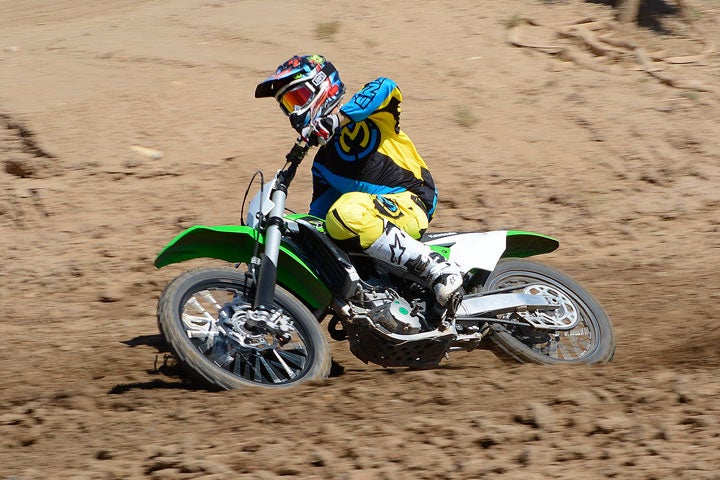
Dear DirtBikes.com:
Loved your review of the 2017 Kawasaki KX250F. Had a question however regarding going up to a 51T rear. It sounds like it was an improvement for the engine performance and may have helped with cornering, but did it help with getting the front tire to plant any better? I have this bike, and it’s great at speed and with stability, but coming off a CRF, the front isn’t as planted as I had hoped, but it’s certainly not terrible either. I’ve worked with some suspension settings, etc., and it’s helped, but since you guys went up 1T in the rear, this essentially pulls the engine farther back and takes weight off the front, although it does shorten the wheelbase. My concern is whether the added tooth takes too much weight off the front and does it make it more challenging to adjust the rear suspension since it has less leverage (axle is moved up 5mm)?
My thoughts regarding the engine are in line with your review. You need to constantly find the sweet spot of the powerband to have good lap times.
Any insights or tips would be appreciated.
Cheers!
Rich Anderson
P.S: the Kawi EFI tuner is mighty expensive, and I can’t find anyone in SoCal with one to borrow. So sad!
Hi, Rich:
Thanks for the kind words regarding our test of the 2017 Kawasaki KX250F. It is nice to know that we are on the same page with some of our readers!
Yes, adding the tooth did help give the engine that little bit more “leverage” that it needed to hit that sweet mid-range punch just a little sooner. Our tester, Ryan Abbatoye, also noticed a change in handling, and you raise an excellent point that people often forget about, how changing gearing will have an effect on a motorcycle’s front/rear weight bias and could possibly change the handling character of the bike.
Now, in the case of the KX250F, we were dealing with a bike that is a bit more deliberate in the steering department than other bikes in its class, and yes, the wheelbase change did just as you suggested: by pulling the rear axle 5mm closer to the engine, we made it steer more quickly by putting more weight on the rear wheel. While we had no front-end traction issues during our test, we were testing on a fairly deep, well-groomed track. You didn’t really discuss what kind of terrain your track has (sand, clay, wet, dry-slick… the list goes on).
However, you say that you have front-end traction issues, and we’re to help! First of all, don’t make the base assumption that every time you change to a larger or smaller sprocket, you are stuck with the corresponding wheelbase change as well. Motorcycle retailers–both online and down on the block–often sell chain link kits that feature individual links and, yes, half links, that allow you to alter sprocket size without seriously disturbing your wheelbase. So, you can get more punch or a taller top speed and retain the same handling character. Some people are a little sketchy on half links, but we’ve never had one fail on us.
Second, remember what other changes you can make, to try and get a little more front-end traction. In order, we would, 1) try a different tire brand/compound or a slightly different tire pressure with your existing tire. We run 12 psi in our tires on most motocross tracks but wouldn’t hesitate to drop half a psi or a full psi if we were looking for a little more front end grip. 2) Raise or lower the forks in the triple clamps by a few millimeters. Raising the legs so that the tops stick farther out the top of the clamp will add weight bias to the front end of the motorcycle, and it will also shorten the rake, which could lead to quicker steering into the corner, but it could cause the front end to push in mid-corner and also sacrifice straight-line stability. Lowering the legs will pretty much do the exact opposite.
The third thing we might try is to add a little preload to the rear end. Despite what people say, adding preload will not make the spring stiffer–it does not alter the spring rate whatsoever. What it will do is increase the amount of force through the rear wheel that is needed to move the spring the same amount as before, causing the rear suspension to “feel stiffer” and less compliant. Some weight that used to sag more into the rear cannot do that, and that could translate to more front-end bite. If you are already in the ballpark with the spring–in other words, it is the right spring rate for your weight in full gear and your riding style, then you should be able to add or take away a small amount preload and mess with your adjusters to get pretty close to the same suspension feel with the preload adjusted differently. Remember that your shock doesn’t hold up the rear end of your motorcycle, the spring does. If you don’t believe us, take your spring off, put your shock back on and go have lap to see how that feels!
It almost goes without saying that the manufacturers put in a lot of engineering and testing time to make their bikes achieve intended performance girls for a wide variety of riders. Riding style obviously plays a large part in what you feel as an individual. It never hurts to try a few changes to see whether you are getting closer to are farther away from the optimum feel through the seat of your pants.
 Your Privacy Choices
Your Privacy Choices